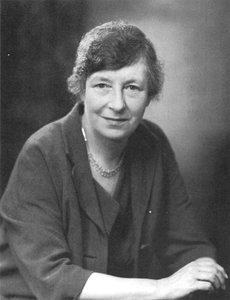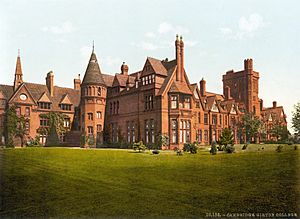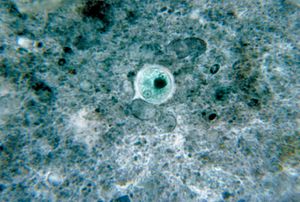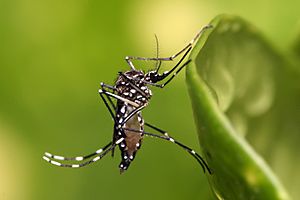Ann Bishop (biologist) facts for kids
Quick facts for kids
Ann Bishop
|
|
|---|---|
 |
|
| Born | 19 December 1899 Manchester, England
|
| Died | 7 May 1990 (aged 90) Cambridge, England
|
| Alma mater | Manchester University and Cambridge University |
| Known for | Studies of drug resistance in Plasmodium |
| Parents |
|
| Scientific career | |
| Fields | Biology, protozoology, parasitology |
| Institutions | Girton College, Cambridge |
| Thesis | (1926) |
| Influences | Sydney J. Hickson |
Ann Bishop (born December 19, 1899 – died May 7, 1990) was a British biologist. She worked at Girton College at the University of Cambridge. She was also a Fellow of the Royal Society, which is a very important group of scientists. Ann Bishop was one of the few women to be part of this group at the time.
She was born in Manchester, England, but spent most of her working life in Cambridge. Ann Bishop was an expert in protozoology (the study of tiny, one-celled animals called protozoa) and parasitology (the study of parasites). Her early work looked at tiny parasites called ciliates. This included the parasite that causes a sickness called blackhead disease in turkeys. Later, for her advanced degree, she studied parasitic amoebae. She also looked for medicines to treat diseases caused by amoebae, like amoebic dysentery.
Ann Bishop's most famous work was about Plasmodium, the parasite that causes malaria. She studied different medicines to treat malaria. Later, she researched how these parasites could become resistant to medicines. This research was very helpful to the British military during World War II. She also found out that these parasites could develop "cross-resistance" to different drugs at the same time. Bishop also discovered a new protozoan called Pseudotrichomonas keilini. She worked with Aedes aegypti, a type of mosquito that spreads malaria, as part of her research. In 1959, she was chosen to be a Fellow of the Royal Society. She also started the British Society for Parasitology and was on the World Health Organization's Malaria Committee.
Contents
Ann Bishop's Life
Ann Bishop was born in Manchester, England, on December 19, 1899. Her father, James Kimberly Bishop, made furniture. Her mother, Ellen Bishop, was from Bedfordshire. Ann had one younger brother. When she was young, Ann wanted to join her family's business. But her father encouraged her to go to university, and she soon became interested in science.
Ann loved music from a young age. She often went to concerts by the Halle Orchestra in Manchester. As a scientist, she liked to work carefully on her own or with other scientists who were very precise. She spent most of her life at Girton College. People at The Guardian newspaper even called her the "Girtonian of Girtonians" in her obituary. She was a good cook, but she didn't like that recipes often didn't use scientific measurements. She liked things to be precise, even in cooking!
Ann Bishop was known at the college for her special hats. She wore one to breakfast every day before walking to the Molteno Institute. This walk was about 3.5 miles (5.6 km) long. She was also good at needlework and enjoyed art, but she didn't like modern art. Her hobbies included walking and traveling, especially in the Lake District in England. However, she rarely left Britain. She also spent time in London each year, going to the opera, ballet, and art galleries.
Towards the end of her life, Ann Bishop had arthritis, which made it hard for her to move around. She became very interested in the history of biology and medicine. Ann Bishop died at age 90 from pneumonia after a short illness. Many of her friends attended her memorial service at the college chapel.
Ann Bishop's Education
Ann Bishop was taught at home until she was seven. Then she went to a private elementary school until she was nine. In 1909, when she was ten, she started at the Fielden School in Manchester. She studied there for three years. She finished her high school education at the Manchester High School for Girls.
Ann wanted to study chemistry at university. But she hadn't studied enough physics, so she couldn't take her preferred chemistry course. Instead, in October 1918, she started at Manchester University. She studied botany, chemistry, and zoology. That first year of zoology sparked her lifelong interest in the field. She earned her Bachelor of Science degree in 1921 and her master's degree in 1922. During her studies, she learned about ciliates from local ponds with her teachers, R.A. Wardle and Geoffrey Lapage.
After two years of university, she won a special award called the John Dalton Natural History Prize. She then began working with another protozoologist, Sydney J. Hickson, who was a Fellow of the Royal Society. In 1932, she received her Doctor of Science (D.Sc.) degree from Manchester University for her work on the blackhead parasite. In 1941, she received another Doctor of Science (Sc.D.) degree from the University of Cambridge. However, at that time, women were not given full degrees from Cambridge.
Ann Bishop's Scientific Work
Early Research on Parasites
Ann Bishop's first big research project was with Sydney J. Hickson. They studied how a large ciliate called Spirostomum ambiguum reproduced. In 1923, while at Manchester University, Bishop became an honorary research fellow. In 1924, she became a part-time teacher in the Zoology Department at Cambridge. She was one of only two women there, and sometimes she wasn't treated the same as the men. For example, she wasn't allowed to sit at the main table with the men during tea time. She continued her work with Spirostomum as the only protozoologist in the department.
In 1926, she left that job to work with Clifford Dobell at the National Institute for Medical Research for three years. With Dobell, Bishop studied parasitic amoebae found in the human gut. She focused on Entamoeba histolytica, the species that causes amoebic dysentery. Dobell, Bishop, and Patrick Laidlaw studied medicines like emetine to treat amoebic diseases. Later in her career, she named an amoeba group, Dobellina, after her mentor, Dobell.
Working at the Molteno Institute
Ann Bishop spent most of her career at Cambridge's Molteno Institute for Parasite Biology. She returned there in 1929. Her work there continued her research with Dobell. She studied how the nucleus divides in parasitic flagellates and amoebae from different animals. During this time, she found a type of protozoan that could live without much oxygen. She also discovered a new species, Pseudotrichomonas keilini. She named it after her colleague David Keilin and because it looked like the Trichomonas group.
Her research at Manchester with H.P. Baynon involved finding and studying the turkey blackhead parasite (Histomonas meleagridis). This study helped create a new way to grow parasites from infected areas on the liver. Bishop and Baynon were the first scientists to isolate Histomonas and prove it caused blackhead disease. Ann Bishop's knowledge of parasitic protozoa led to her most famous work: a deep study of the malaria parasite (Plasmodium) and possible medicines to treat the disease.
Between 1937 and 1938, Bishop studied how different things, like substances in blood and temperature, affected how the Aedes aegypti mosquito fed. This mosquito spreads chicken malaria (Plasmodium gallinaceum). She also looked at what helped Plasmodium reproduce. This work helped with later research on a malaria vaccine. Her next work was important because of World War II. During the war, she looked for other medicines to treat malaria. Her research helped Britain because the main malaria medicine, quinine, was hard to get. This was because Japan had taken over the Dutch West Indies, where quinine came from. From 1947 to 1964, she led the Institute's Chemotherapy Research Institute.
Bishop's work then focused on how parasites and the animals they lived in (called hosts) became resistant to medicines. This research helped her become a member of the Royal Society. One important study she did showed that the parasite itself didn't become resistant to quinine. But the host animals could become resistant to a drug called proguanil. Her lab research was proven correct when the drugs she studied were used to treat patients with tertian malaria. This is a type of malaria where the fever happens every third day. She also studied drugs like pamaquine and atebrin, along with proguanil. Only proguanil was shown to cause drug resistance. Other studies showed that malaria parasites could develop cross-resistance to other malaria drugs. Bishop worked at Molteno until 1967. Her research methods were later used in studies on rodents and humans.
Awards and Lasting Impact
Ann Bishop received several special awards and fellowships during her career. In 1932, she became a Yallow Fellow of Girton College. She held this honor until she died in 1990. Bishop was also a Beit Fellow from 1929 to 1932. The Medical Research Council gave her a grant in 1937, which started her study of Plasmodium. In 1945 and 1947, she helped organize Girton College's Working Women's Summer School. This school helped women who had stopped their formal education at age 14 to continue learning. She was elected to the Royal Society in 1959. At one point, she was also a member of the Malaria Committee for the World Health Organization.
The British Society for Parasitology was started in the 1950s, mostly because of Ann Bishop's hard work. At first, she only had a small amount of money and a secretary to start the Society. To raise more money, Bishop would pass around a pudding basin at the Society's meetings. The society was first a small part of the Institute of Biology at Cambridge. But it became its own group in 1960, with Bishop as its leader. She was the president of the group, then called the Institute of Biology Parasitology Group, from 1960 to 1962. Later, the Department of Biology asked her to be the head of the department, but she said no because the role was too public. For 20 years, Ann Bishop was an editor for the scientific journal Parasitology.
Because of her long connection with Girton College, a plaque was placed to remember her life. The words on the plaque are from Virgil and say, "Felix, qui potuit rerum cognoscere causas". In Latin, this means "Happy is the one who has been able to get to know the causes of things." In 1992, the British Society for Parasitology created an award in Bishop's name, called the Ann Bishop Travelling Award. This award helps young parasitologists travel for field work to places where their parasites of interest are found naturally.
Images for kids
See also
In Spanish: Ann Bishop (bióloga) para niños





